ALIN & HER CATS
i love cats
Saturday, 15 October 2016
Saturday, 24 September 2016
HOW TO TAKE CARE OF CAT
There are a few basics to understand in
taking care of a cat. Proper feeding, housing, litter box, grooming, handling,
play and exercise are very important for your cat to live a long and happy
life. Also take your cat to the vet for a check-up at least once a year. Here
are some cat care tips for optimal cat care:
·
Feeding
Feed your cat premium cat food. High quality cat foods meeting AAFCO cat food standards will ensure that your cat gets a balanced diet with the right nutrients. Feline diets deficient in certain nutrients can cause diseases, including blindness.
Provide your cat with a fresh supply of water throughout the day. If you make a change to your cat's diet, do so as gradually as possible. If moist pet food goes uneaten for two hours, refrigerate it.
Feed your cat premium cat food. High quality cat foods meeting AAFCO cat food standards will ensure that your cat gets a balanced diet with the right nutrients. Feline diets deficient in certain nutrients can cause diseases, including blindness.
Provide your cat with a fresh supply of water throughout the day. If you make a change to your cat's diet, do so as gradually as possible. If moist pet food goes uneaten for two hours, refrigerate it.
·
Housing
Keeping your cat indoors or outdoors can depend on many factors, including your lifestyle and where you live. Many cat organizations recommend keeping your cat indoors for safety, better health and a longer life.
Allow your cat to choose favorite spots to hang out around the house, and then make it more comfortable with blankets and pillows, or a cat bed. You can provide your cat with scratch pads or scratching posts as well.
Keeping your cat indoors or outdoors can depend on many factors, including your lifestyle and where you live. Many cat organizations recommend keeping your cat indoors for safety, better health and a longer life.
Allow your cat to choose favorite spots to hang out around the house, and then make it more comfortable with blankets and pillows, or a cat bed. You can provide your cat with scratch pads or scratching posts as well.
·
Litter box
One of the most important aspects of cat care is regarding the litter box. The number one reason adult cats are brought to shelters is for unresolved litter box problems.
Use a good quality litter for odor control and ease of cleaning. Place the litter box in a relatively quiet area that your cat likes to frequent and make sure there are multiple escape routes. Also make sure to provide enough litter boxes for your cat. We suggest following the one plus one rule - one litter box for each cat in the house plus one more.
One of the most important aspects of cat care is regarding the litter box. The number one reason adult cats are brought to shelters is for unresolved litter box problems.
Use a good quality litter for odor control and ease of cleaning. Place the litter box in a relatively quiet area that your cat likes to frequent and make sure there are multiple escape routes. Also make sure to provide enough litter boxes for your cat. We suggest following the one plus one rule - one litter box for each cat in the house plus one more.
·
Grooming
Groom weekly (or more frequent if possible) to prevent hairballs, improve the look of your cat's coat, and to check on your cat's well being. Use this time to examine your cat for common health problems as well. Check your cat's gums, teeth, eyes, ears (look for signs of ear mites), skin, and limbs for possible problems. Also check for signs of pain, swelling or injury.
Most cats learn to enjoy the grooming process, and this can be a rewarding interaction between you and your pet as well.
Groom weekly (or more frequent if possible) to prevent hairballs, improve the look of your cat's coat, and to check on your cat's well being. Use this time to examine your cat for common health problems as well. Check your cat's gums, teeth, eyes, ears (look for signs of ear mites), skin, and limbs for possible problems. Also check for signs of pain, swelling or injury.
Most cats learn to enjoy the grooming process, and this can be a rewarding interaction between you and your pet as well.
o
Brushing
For longhaired cats and to minimize shedding, you can brush your cat daily. For problems with matted fur, use your fingers or a matt comb to work out the tangles.
For longhaired cats and to minimize shedding, you can brush your cat daily. For problems with matted fur, use your fingers or a matt comb to work out the tangles.
o
Nails
Check your cat's nails regularly and clip them as needed. You can provide scratching posts or pads to help keep your cats nails trimmed naturally. However, if your cat's claws get too long, they may curve back into the toe pad. They are also more likely to get caught on something if they're not kept trimmed. Make sure to use good quality clippers designed for cats to trim the claws. Press the paw gently to expose the nails. Make sure you clip well to the outside of the tiny darkish pink vain, called the quick. In case of error, clipping too short and causing bleeding to occur, have a blood stop or cornmeal available to use as a coagulant.
Check your cat's nails regularly and clip them as needed. You can provide scratching posts or pads to help keep your cats nails trimmed naturally. However, if your cat's claws get too long, they may curve back into the toe pad. They are also more likely to get caught on something if they're not kept trimmed. Make sure to use good quality clippers designed for cats to trim the claws. Press the paw gently to expose the nails. Make sure you clip well to the outside of the tiny darkish pink vain, called the quick. In case of error, clipping too short and causing bleeding to occur, have a blood stop or cornmeal available to use as a coagulant.
o
Ears
Cleaning Checking your cat's ears should be done weekly as well. Clean them as needed, using a small amount of veterinary ear cleaner and a cotton ball.
Cleaning Checking your cat's ears should be done weekly as well. Clean them as needed, using a small amount of veterinary ear cleaner and a cotton ball.
o
Eyes
The wax-like secretions that form in the corners of cat's eyes should be gently cleared away to prevent irritation. Use a damp cotton ball to clean around the cat's eye. Take extra care not to touch the eyeball.
The wax-like secretions that form in the corners of cat's eyes should be gently cleared away to prevent irritation. Use a damp cotton ball to clean around the cat's eye. Take extra care not to touch the eyeball.
o
Bathing
Bathing is not necessary for all cats as they are excellent at grooming themselves. However some breeds, like the longhaired varieties, do require regular baths. Place a small towel over the side of the tub to provide a surface for your cat to cling onto. Hold the cat with one hand and lather it with your other hand. Water temperature should be approximately 100 degrees. Wash your cat's head, ears and neck first to prevent any fleas that are on your cat from taking refuge there while you clean the rest of its body.
Bathing is not necessary for all cats as they are excellent at grooming themselves. However some breeds, like the longhaired varieties, do require regular baths. Place a small towel over the side of the tub to provide a surface for your cat to cling onto. Hold the cat with one hand and lather it with your other hand. Water temperature should be approximately 100 degrees. Wash your cat's head, ears and neck first to prevent any fleas that are on your cat from taking refuge there while you clean the rest of its body.
·
Handling
Handle your cat frequently. Give your cat at least 10 minutes of physical attention every day. Take time to pet, stroke, scratch, or brush your cat for at least 10 minutes daily. It will calm and relax both not only your cat but you too. Recent evidence shows that contact with cats may actually reduce your risk of heart attack by as much as thirty percent! What a great bonus for giving good cat care.
If you can, start handling your cat when it's a kitten. This early socialization helps a cat enjoy handling later in life, and makes it easier when it comes time for check-ups at the vet. Also make sure you massage your cat's paws and toes often so your cat gets used to having them restrained. This will help immensely when having to trim its nails.
Handle your cat frequently. Give your cat at least 10 minutes of physical attention every day. Take time to pet, stroke, scratch, or brush your cat for at least 10 minutes daily. It will calm and relax both not only your cat but you too. Recent evidence shows that contact with cats may actually reduce your risk of heart attack by as much as thirty percent! What a great bonus for giving good cat care.
If you can, start handling your cat when it's a kitten. This early socialization helps a cat enjoy handling later in life, and makes it easier when it comes time for check-ups at the vet. Also make sure you massage your cat's paws and toes often so your cat gets used to having them restrained. This will help immensely when having to trim its nails.
·
Play and Exercise
Try to play with your cat every day to make sure it gets enough exercise. Regular exercise is an important part of cat care as it helps your cat maintain body tone, muscle and keeps it feeling younger longer. You can play using a variety of dangle toys and teasers. You can also play by chasing your cat around the house.
Besides being fun, there are great bonuses to play and exercise. Getting your cat exercising daily will help lower risks of diseases and minimize vet bills.
Try to play with your cat every day to make sure it gets enough exercise. Regular exercise is an important part of cat care as it helps your cat maintain body tone, muscle and keeps it feeling younger longer. You can play using a variety of dangle toys and teasers. You can also play by chasing your cat around the house.
Besides being fun, there are great bonuses to play and exercise. Getting your cat exercising daily will help lower risks of diseases and minimize vet bills.
TYPE OF CATS

American Bobtail
While the breed is still developing, breeders say that Bobtails are playful, energetic, and friendly, and possess an uncanny ...
Read more about the American Bobtail cat breed.
Read more about the American Bobtail cat breed.

American Curl
Curls have qualities other than the whimsical ears to make them attractive pets. They are people cats that do not show any of ...
Read more about the American Curl cat breed.
Read more about the American Curl cat breed.

American Shorthair
When describing the American Shorthair, the expression 'happy medium' springs to mind. These all-American cats are medium in ...
Read more about the American Shorthair cat breed.
Read more about the American Shorthair cat breed.

American Wirehair
Wirehairs are people cats that crave human attention and affection. They are active without being hyper, and affectionate ...
Read more about the American Wirehair cat breed.
Read more about the American Wirehair cat breed.

Balinese
Balinese cats are smart, sweet, and fun to be around. Like the Siamese, they are known for their ability to communicate vocally, ...
Read more about the Balinese cat breed.
Read more about the Balinese cat breed.

Bengal
The Bengal may look like a wild cat, but breeders insist that the Bengal is as lovably friendly and docile as any full-blooded ...
Read more about the Bengal cat breed.
Read more about the Bengal cat breed.

Birman
Birmans are affectionate, gentle, and faithful companions with an air of dignity that seems to invite adoration by their human ...
Read more about the Birman cat breed.
Read more about the Birman cat breed.

Bombay
If an aloof, independent cat is what you're craving, this breed isn't for you. Bombays are attached to their family, and tend to ...
Read more about the Bombay cat breed.
Read more about the Bombay cat breed.

British Shorthair
If you're looking for a cat that will loot your refrigerator and swing dizzily from your chandeliers, then the British Shorthair ...
Read more about the British Shorthair cat breed.
Read more about the British Shorthair cat breed.

Burmese
Breeders and fanciers report that Burmese are amusing, playful, and super-smart, the perfect interactive cats for home, office, ...
Read more about the Burmese cat breed.
Read more about the Burmese cat breed.

Chartreux
Known for their hunting prowess, Chartreux cats may have been taken in by those monks long ago to rid the monastery of vermin. ...
Read more about the Chartreux cat breed.
Read more about the Chartreux cat breed.

Cornish Rex
Cornish Rexes are good for folks who like having their lives run by active, inquisitive, gazelle-like felines that love a good ...
Read more about the Cornish Rex cat breed.
Read more about the Cornish Rex cat breed.
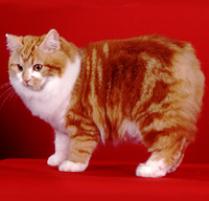
Cymric
The personality of the Cymric has won a strong following despite the breeding challenges. Cymrics are intelligent, fun-loving ...
Read more about the Cymric cat breed.
Read more about the Cymric cat breed.

Devon Rex
Devons have been compared to pixies, elves, and, of course, space aliens for their jumbo-sized satellite-dish ears, large, ...
Read more about the Devon Rex cat breed.
Read more about the Devon Rex cat breed.

Egyptian Mau
While fanciers might at first be attracted to the Egyptian Mau's beautiful spotted coat, most become enthusiasts because of the ...
Read more about the Egyptian Mau cat breed.
Read more about the Egyptian Mau cat breed.

Exotic Shorthair
Some folks who don't appreciate that laid-back, mellow personality label Persians and their relatives 'furniture with fur', but ...
Read more about the Exotic Shorthair cat breed.
Read more about the Exotic Shorthair cat breed.
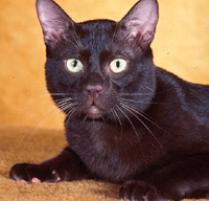
Havana Brown
More distinctive than the muzzle, ears, or minklike coat is the Havana Brown?s personality. Although still quite rare and for ...
Read more about the Havana Brown cat breed.
Read more about the Havana Brown cat breed.
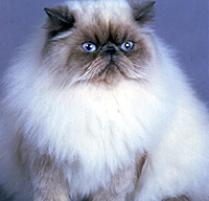
Himalayan
Himmies, as fanciers call them, are perfect indoor cat companions. They are gentle, calm, and sweet-tempered, but they possess a ...
Read more about the Himalayan cat breed.
Read more about the Himalayan cat breed.

Japanese Bobtail
Bobs make outstanding companions. They're curious, bold, intelligent, and alert, and easily adjust to new people, situations, ...
Read more about the Japanese Bobtail cat breed.
Read more about the Japanese Bobtail cat breed.
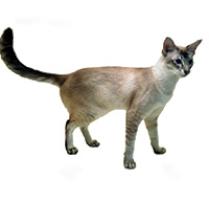
Javanese
Javanese cats, like their Balinese relatives, are playful, devoted, and always eager to tell you their views on life, love, and ...
Read more about the Javanese cat breed.
Read more about the Javanese cat breed.

Korat
Korats are not as vocal as their Siamese comrades; they have other ways of getting their wishes across. At dinnertime they'll ...
Read more about the Korat cat breed.
Read more about the Korat cat breed.

Maine Coon
No breed has a monopoly on love and affection, but there's got to be some good reason that the Maine Coon has clawed his way up ...
Read more about the Maine Coon cat breed.
Read more about the Maine Coon cat breed.

Manx
The Manx's personality is probably the reason the breed has won such a strong following despite the physical difficulties and ...
Read more about the Manx cat breed.
Read more about the Manx cat breed.

Munchkin
For their part, Munchkins, oblivious to the controversy surrounding them, go on being just what they are, cats; self-assured and ...
Read more about the Munchkin cat breed.
Read more about the Munchkin cat breed.

Nebelung
Nebelungs are mild, soft-spoken, and gentle. They are generally reserved around strangers, ranging from hiding-under-the-bed ...
Read more about the Nebelung cat breed.
Read more about the Nebelung cat breed.

Norwegian Forest Cat
Natural athletes, Norwegian Forest Cats love to investigate counters, bookcases, and the loftiest peaks of their cat trees. ...
Read more about the Norwegian Forest Cat cat breed.
Read more about the Norwegian Forest Cat cat breed.
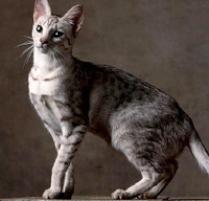
Ocicat
Ocicats may look wild, but they are actually affectionate, curious, and playful, and possess a very strong devotion to their ...
Read more about the Ocicat cat breed.
Read more about the Ocicat cat breed.

Oriental
The personality of the Oriental is as distinctive as the multicolored exterior. They are natural entertainers, full of ...
Read more about the Oriental cat breed.
Read more about the Oriental cat breed.
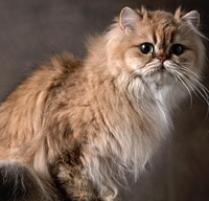
Persian
If you want your cats bouncing around like hyperactive popcorn, don't buy a Persian. Persians are perfect companions, if you ...
Read more about the Persian cat breed.
Read more about the Persian cat breed.
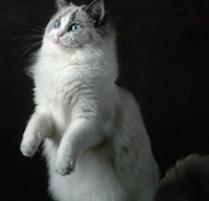
Ragdoll
Docile, mild-mannered, and congenial, Rag-dolls make ideal indoor companions. One of the nicest features of these cats is their ...
Read more about the Ragdoll cat breed.
Read more about the Ragdoll cat breed.

Russian Blue
Russian Blues are gentle, genteel cats, and are usually reserved, or absent, when strangers are around. When they're with their ...
Read more about the Russian Blue cat breed.
Read more about the Russian Blue cat breed.

Scottish Fold
Scottish Folds are intelligent, sweet-tempered, soft-spoken, and easily adaptable to new people and situations. They are very ...
Read more about the Scottish Fold cat breed.
Read more about the Scottish Fold cat breed.
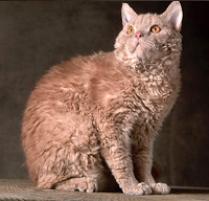
Selkirk Rex
Selkirks are fun-loving, mellow cats with a generous measure of love and affection for their human companions. Very people-...
Read more about the Selkirk Rex cat breed.
Read more about the Selkirk Rex cat breed.

Siamese
Some cats seem to think that a purr or a friendly rub speaks louder than words. Siamese are not of this school of thought and ...
Read more about the Siamese cat breed.
Read more about the Siamese cat breed.

Siberian
Siberians are affectionate cats with a good dose of personality and playfulness. They are amenable to handling, and breeders ...
Read more about the Siberian cat breed.
Read more about the Siberian cat breed.

Singapura
Singapuras, happily unaware of the controversy surrounding them, go right on being what they are: pesky people pleasers. At home ...
Read more about the Singapura cat breed.
Read more about the Singapura cat breed.

Snowshoe
Breeders brave enough to take on the Snowshoe challenge find that the cat pays back the effort in love and affection. Anyone ...
Read more about the Snowshoe cat breed.
Read more about the Snowshoe cat breed.

Somali
With all the virtues of the Abyssinian and adorned by a gorgeous semi-long coat, the Somali is a beautiful and lively addition ...
Read more about the Somali cat breed.
Read more about the Somali cat breed.

Sphynx
According to the French breed standard, the Sphynx is part monkey, part dog, part child, and part cat. The breed does seem to ...
Read more about the Sphynx cat breed.
Read more about the Sphynx cat breed.

Tonkinese
The Tonkinese has a winsome personality, not surprising since the Burmese and Siamese are prized for their temperaments. ...
Read more about the Tonkinese cat breed.
Read more about the Tonkinese cat breed.

Turkish Angora
Turkish Angora fanciers are as attached to their cats as their cats are to them. Angoras seem to invoke strong responses in ...
Read more about the Turkish Angora cat breed.
Read more about the Turkish Angora cat breed.

Turkish Van
While you might be drawn to the Van for his fascination with water, you'll fall in love with the breed for his other qualities. '...
Read more about the Turkish Van cat breed.
Read more about the Turkish Van cat breed.
CATS?
 |
| ALIN & HER CATS |
The domestic cat (Latin: Felis
catus) or the feral cat (Latin: Felis
silvestris catus) is a small, typically furry, carnivorousmammal. They are often
called house cats when kept as indoor pets or simply cats when
there is no need to distinguish them from other felids and felines. Cats
are often valued by humans for
companionship and for their ability to hunt vermin. There are more
than 70 cat breeds; different associations proclaim different numbers according
to their standards.
Cats are similar in anatomy to the
other felids, with a strong, flexible body, quick reflexes, sharp retractable
claws, and teeth adapted to killing small prey. Cat senses fit a crepuscular and
predatory ecological niche.
Cats can hear sounds too faint or too high infrequency for
human ears, such as those made by mice and other small animals. They can see in
near darkness. Like most other mammals, cats have poorer color vision and a
better sense of smell than
humans. Cats, despite being solitary hunters, are a social species and cat communication includes
the use of a variety of vocalizations (mewing, purring, trilling, hissing, growling, andgrunting), as well as cat pheromones and
types of cat-specific body
language.
Cats have a high breeding rate. Under controlled breeding, they
can be bred and shown as registered pedigree
pets, a hobby known as cat fancy. Failure to
control the breeding of pet cats by neutering and the abandonment of former household pets has
resulted in large numbers of feral cats worldwide,
requiring population control. This has contributed, along
with habitat destruction and other factors, to the extinction of many bird
species. Cats have been known to extirpate a bird species within specific
regions and may have contributed to the extinction of isolated island
populations. Cats are thought to be primarily, though not solely, responsible
for the extinction of 33 species of birds, and the presence of feral and free
ranging cats makes some locations unsuitable for attemptedspecies reintroduction in
otherwise suitable locations.
Since cats were venerated in ancient
Egypt, they were commonly believed to have been domesticated there, but
there may have been instances of domestication as early as the Neolithic from
around 9,500 years ago (7,500 BC). A genetic study in 2007
concluded that domestic cats are descended from Near Eastern wildcats, having
diverged around 8,000 BC in West Asia. A 2016
study found that leopard cats were
undergoing domestication independently in China around 5,500 BC, though this
line of partially domesticated cats leaves no trace in the domesticated
populations of today.
As of a 2007 study, cats are the second most popular pet in the United States by
number of pets owned, behind freshwater fish.
Subscribe to:
Comments (Atom)
